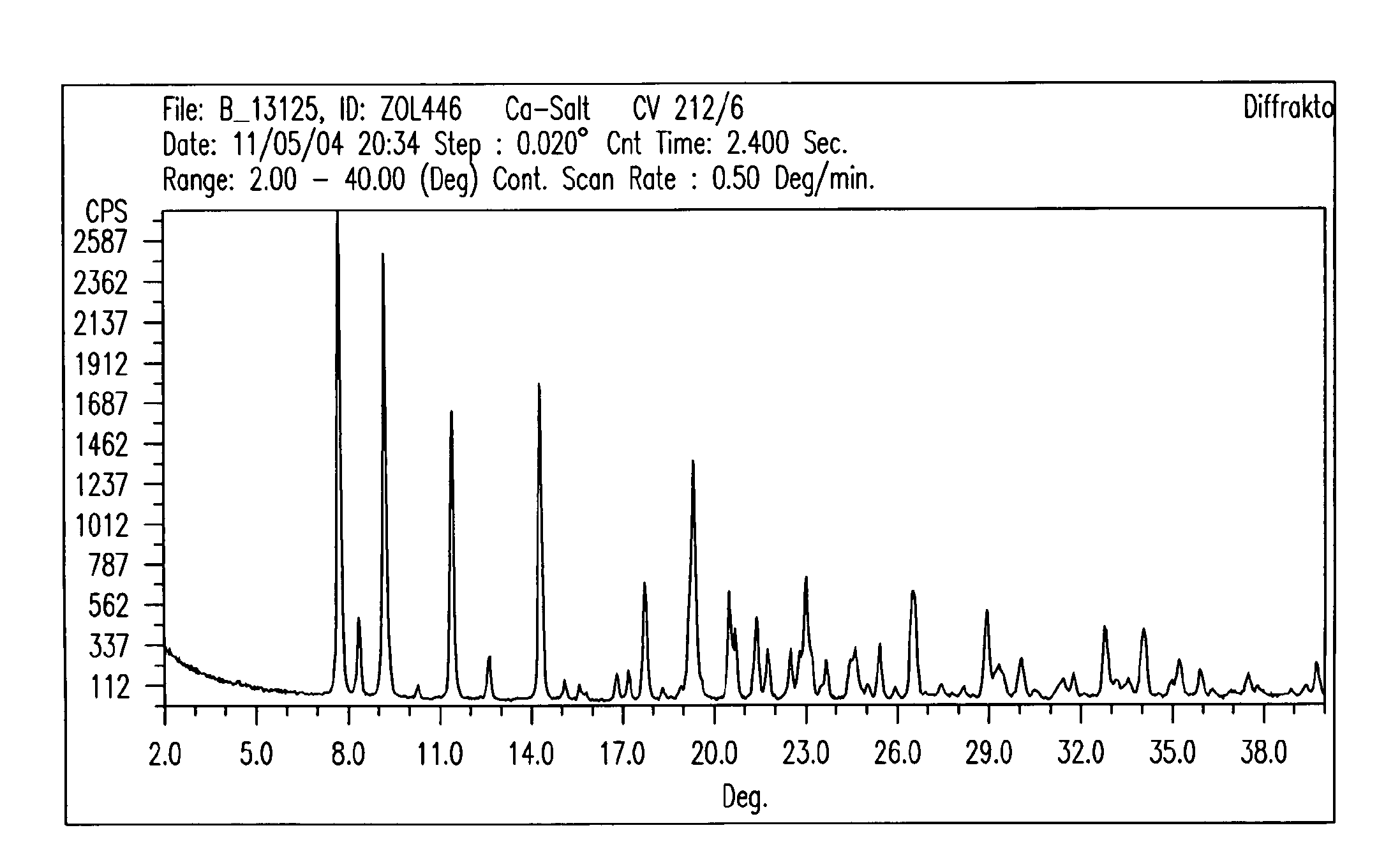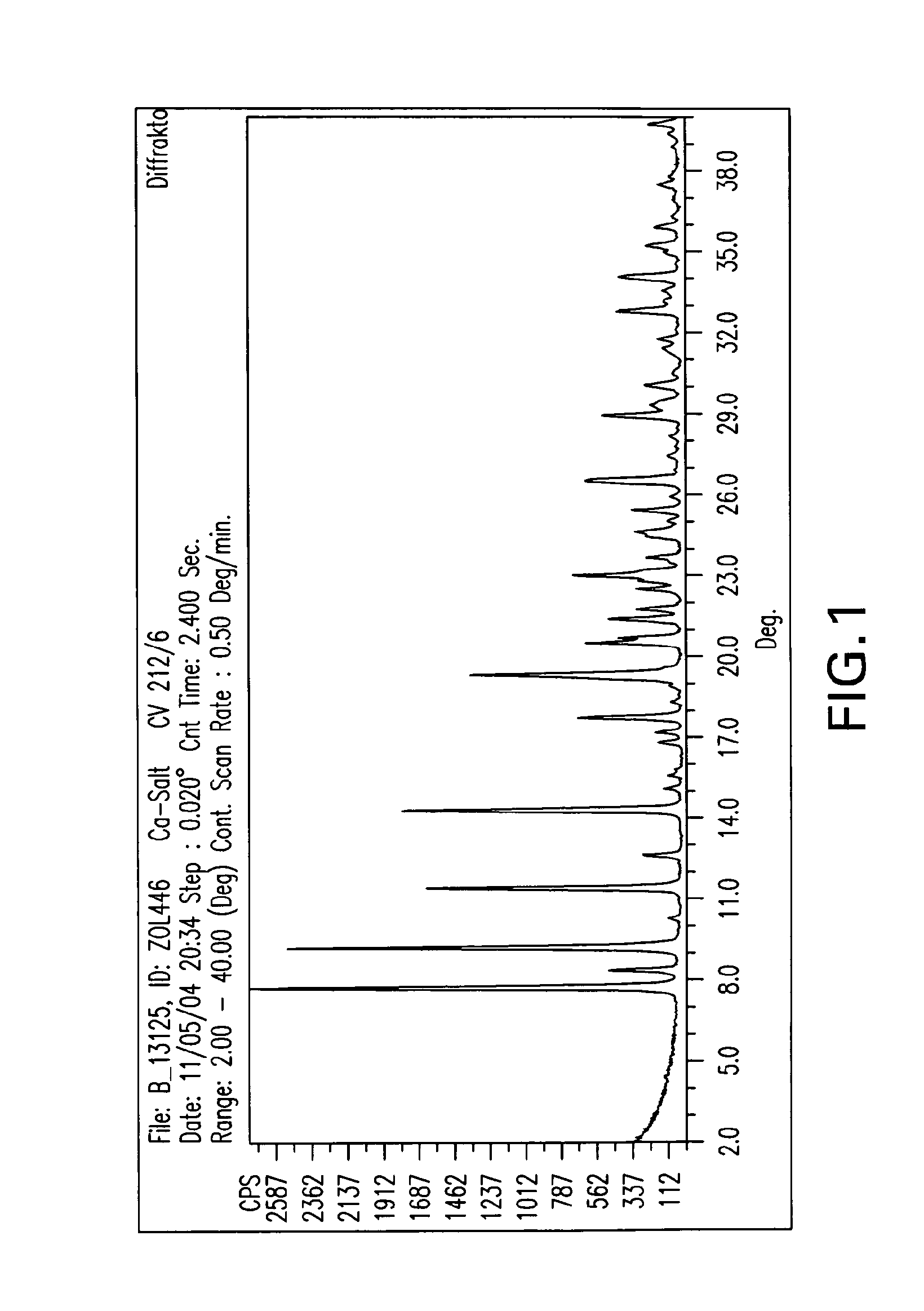Crystalline forms of zoledronic acid
a technology of zoledronic acid and crystalline forms, which is applied in the direction of biocide, group 5/15 element organic compounds, drug compositions, etc., can solve the problem that different polymorphic forms of the same drug may have substantial differences in certain pharmaceutically important properties
- Summary
- Abstract
- Description
- Claims
- Application Information
AI Technical Summary
Problems solved by technology
Method used
Image
Examples
example 1
Process for Making the Crystalline Form of the 1:2 Calcium Salt of Zoledronic Acid
[0138]In a 2,500 mL 3-necked flask with mechanical stirrer, 50 g zoledronic acid and 1380 mL water are added. This mixture is heated to about 90° C. until everything goes into solution. To this clear solution a solution of 19 g calcium chloride dihydrate in 345 mL water is added. The mixture is cooled to room temperature and stirred over night. The precipitated Ca salt is then isolated by filtration, washing with water and dried in a vacuum oven at 50° C. over night. This gives 49.8 g Ca salt of the following composition: C: 18.93; H: 3.82; N: 8.65; P: 20.1; Ca: 6.36; H2O: 8.48. This corresponds to a trihydrate. m.p.>230° C.
example 2
Process for Making the Crystalline Form of the 1:1 Calcium Salt of Zoledronic Acid
[0139]In a Erlenmeyer flask, 2.9 g zoledronic acid are dissolved in 10 mL sodium hydroxide solution 2 N. To this solution a solution of 2.22 g calcium chloride in 80 mL water is added at room temperature. After stirring the mixture at room temperature for some hours the formed white precipitate is filtrated and washed with water. Drying over night in a vacuum oven gives 3.9 g of a white product with the following composition: C: 15.46; H:4.18; N: 7.18; P: 16.3; Ca: 10.6; H2O: 18.36.
example 3
Process for Making the Crystalline Form I of the 1:2 Zinc Salt of Zoledronic Acid
[0140]In a 2,500 mL 3-necked flask with mechanical stirrer, 50 g zoledronic acid, 1,382 mL water and 84.5 mL sodium hydroxide solution 2 N are added with stirring. This gives a clear solution. To this solution, a solution of 23.5 g zinc chloride in 346 mL water is added. The resulting-white suspension is stirred over night. The precipitated Zn salt is then isolated by filtration, washing with water and dried in a vacuum oven at 50° C. over night. This gives 51 g Zn salt with the following composition: C: 18.76; H: 3.38; N: 8.65; P: 20.2; Zn: 11.0 and H2O: 3.81, which according to XRPD is a mixture of two modifications.
[0141]By stirring 46.3 g of this product in 2 L ethanol:water 1:1 over night, filtration and drying in a vacuum oven at 50° C. over night 46.9 g of a single modification is obtained. This product has the following composition: C: 18.01; H: 3.62; N: 8.20; P: 19.1; Zn: 10.5 and H2O: 8.08.
PUM
| Property | Measurement | Unit |
|---|---|---|
| body weight | aaaaa | aaaaa |
| body weight | aaaaa | aaaaa |
| body weight | aaaaa | aaaaa |
Abstract
Description
Claims
Application Information
 Login to View More
Login to View More - R&D Engineer
- R&D Manager
- IP Professional
- Industry Leading Data Capabilities
- Powerful AI technology
- Patent DNA Extraction
Browse by: Latest US Patents, China's latest patents, Technical Efficacy Thesaurus, Application Domain, Technology Topic, Popular Technical Reports.
© 2024 PatSnap. All rights reserved.Legal|Privacy policy|Modern Slavery Act Transparency Statement|Sitemap|About US| Contact US: help@patsnap.com










